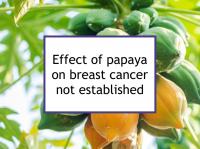Papayas (Carica papaya) and their seeds contain compounds that have been shown to have anti-inflammatory, antihypertensive, antioxidant, anti-amoebic, antiparasitic, antiseptic, wound and burn healing, contraceptive, radioprotective and neuroprotective properties, as well as improving cholesterol profile and assisting with digestion.
Papayas are a very good dietary source of the carotenoids beta-cryptoxanthin and lycopene and also contain beta-carotene. Papayas are also a very good source of caffeic acid, ferulic acid, vitamin C and vitamin A (through their beta-cryptoxanthin and beta-carotene content).
Breast cancer-related effects of eating papaya
Benzyl isothiocyanate (BITC)
Papaya seeds and immature papaya flesh (green papaya) are sources of benzyl isothiocyanate (BITC), which has been shown to selectively induce apoptosis in breast cancer cells, including HER2+ and triple negative (ER-/PR-/HER2-) cells. Ground papaya seeds are sometimes used as part of herbal preparations or, in some cuisines, similarly to black pepper. However, one study found that rats consuming papaya seed extract exhibited liver damage and precancerous liver changes in a dose-dependent manner. Another study found that BITC promoted urinary bladder carcinogenesis in rats. Papaya seed extracts also have been shown to have dose-dependent spermicidal effects, causing human sperm immobilization and death.
Green papaya is a safer source of BITC. However, unlike ripe papaya, green papaya contains a high concentration of a type of latex that incorporates papain, an enzyme which has been shown to produce uterine contractions in rats. This may be the basis for the belief in parts of Asia that consumption of papaya is unsafe during pregnancy. In fact, green papaya is used for female contraception and abortion in some traditional medicine systems.
Papaya flesh carotenoids
The relatively high carotenoid level of papaya flesh suggests that consuming the fruit could serve to protect against breast cancer. Papayas have two possible flesh colors, yellow and red. The red color of red papaya fruit is due to an accumulation of lycopene; the yellow color of yellow papaya is the result of conversion of lycopene to beta-carotene and beta-cryptoxanthin. Papaya pulp has very little BITC.
A number of studies have found an inverse association between breast cancer risk and consumption of foods, such as papayas, that have high levels of carotenoids. A meta-analysis of data from previous prospective studies reported that women in the top quintile (fifth) of total circulating carotenoids had a 19% lower risk of breast cancer compared to those in the lowest quintile. When carotenoids were considered individually in the study, women in the top quintile of lycopene intake were found to have a 22% lower risk of breast cancer than those in the bottom quintile.
Another study of 84,805 postmenopausal women in the Women's Health Initiative Observational Study found that dietary beta-carotene and lycopene were both inversely associated with the risk of hormone receptor positive (ER+/PR+) breast cancer. However, not studies have reported an inverse association between lycopene and breast cancer risk.
A Scandinavian study found that dietary (but not supplemental) beta-carotene had a protective effect against lobular breast cancer in postmenopausal women. Another European study reported that high intake of beta-carotene was protective against breast cancer in postmenopausal women using hormone replacement therapy (HRT). The same study also found that dietary beta-carotene was associated with lowered risk of breast cancer in postmenopausal women with relatively high alcohol consumption.
Dietary carotenoids have also been found to inhibit the cancer-promoting effects of both estradiol (E2) and genistein (a phytoestrogen found in soy), thereby reducing their harmful effects in hormone-dependent breast cancer.
Bottom line
Based on the available evidence, ripe papaya flesh has anti-cancer properties and is safe for consumption by breast cancer survivors and during treatment. On the other hand, the potentially chemopreventive effects of papaya seeds and unripe papaya may be offset by some degree of toxicity.
Additional comments
Papayas are sometimes referred to as paw paws, but the paw paw (Asimina triloba) sold in the U.S. is a different fruit. Papayas normally are consumed without the skin, which is a source of latex (and can cause allergic reactions in susceptible individuals) even in ripe papayas. Although the peel typically is not eaten, papayas should be washed thoroughly since potent pesticides typically are used in growing them and can be transferred to the flesh when the skin is removed. Papaya leaves should not be used in preparing food and papaya leaf extracts should be avoided.
Dried papaya often has been treated with sulfur dioxide to prevent the fruit from oxidizing during and after the drying process, thereby preserving its color. However, sulfur dioxide and its derivatives have been shown to increase the frequency of chromosomal aberrations in mammalian cells and cause oxidative damage in multiple organs of male and female mice. Therefore, we recommend obtaining unsulfured dried papaya where possible.
Sources of information provided in this webpage
The information above, which is updated continually as new research becomes available, has been developed based solely on the results of academic studies. Clicking on any of the underlined terms will take you to its tag or webpage, which contain more extensive information.
Below are links to 20 recent studies concerning this food and its components. For a more complete list, including less recent studies, please click on papaya.
